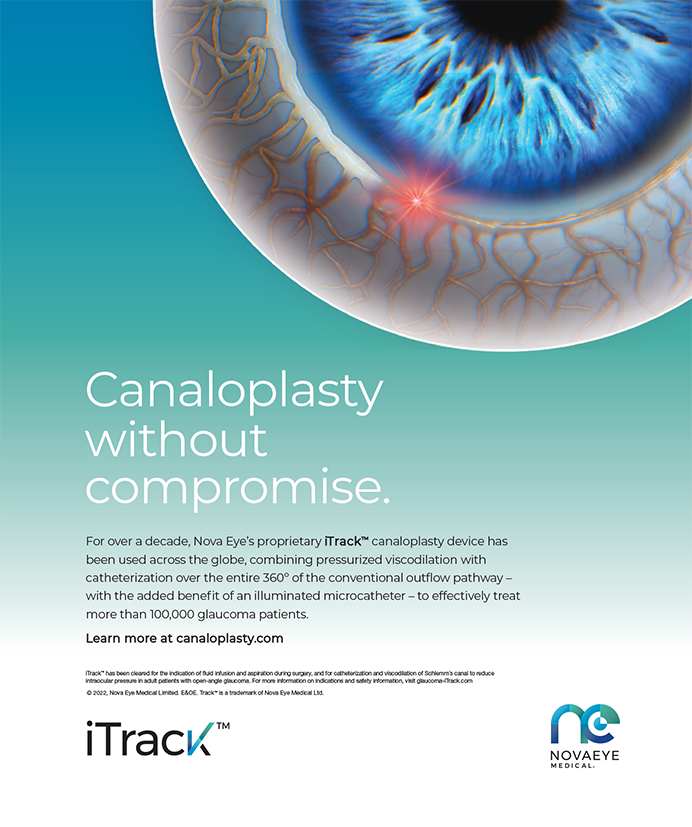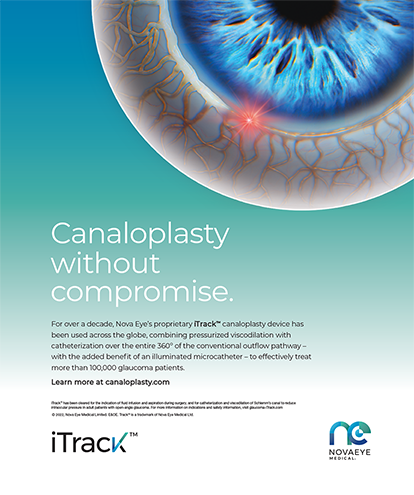Surgeons and their patients can benefit from the technological explosion in lens-based anterior segment surgery. This article discusses how one of my patients with a high degree of mixed astigmatism achieved spectacle independence through refractive lens exchange using a femtosecond laser, toric IOLs, and intraoperative aberrometry.
OPTICAL STATUS
A 55-year-old woman sought a consultation for laser vision surgery. The patient was intolerant of contact lenses, despite many attempts at a successful fitting. She was advised that her dependence on spectacles could best be managed with lens-based rather than corneal surgery. Her BCVA was +6.75 -4.25 X 2 = 20/50 OD and +3.75 -1.00 X 180 = 20/20 OS. The patient's keratometry readings were 45.76 X 95º/40.64 X 5º (5.12 D) OD and 43.86 X 95º/42.08 X 5º (1.79 D) OS. Her right eye was moderately amblyopic but exhibited no physical abnormality in either the anterior or posterior segment. Corneal astigmatism was regular for both eyes.
SURGICAL COURSE
Right Eye
Refractive outcomes after lens-based surgery using a femtosecond laser may achieve tighter refractive results than traditional manual phacoemulsification.1 Given the need for accurate results in cases with a high degree of mixed astigmatism, the patient chose to undergo surgery with the LenSx Laser (Alcon Laboratories, Inc.).
I chose to operate on her right eye first. The laser was programmed to perform the main incision and a 5.2-mm anterior capsulorhexis. Lens fragmentation was not performed, as I generally hydro-express to tilt one edge of the nucleus anterior to the capsular bag in eyes with soft cataracts or clear crystalline lenses for refractive lens exchange. Additionally, the laser was programmed for paired 25º arcuate incisions at a 9-mm optical zone. I anticipated residual corneal astigmatism after implanting an AcrySof IQ Toric IOL (SN6AT9; Alcon Laboratories, Inc.), which corrects 4.10 D of corneal astigmatism at the corneal plane (Figure).
Next, the patient was brought to the OR, and the surgery continued after appropriate preparation and draping. Under the protection of DiscoVisc (Alcon Laboratories, Inc.) for endothelial safety, the nucleus was phaco-aspirated using epinuclear settings. After completing cortical cleanup and polishing the posterior capsule, I used the ORange system (WaveTec Vision) to confirm the IOL's power (+27.50 D). The anterior subcapsular lens epithelial cells were removed with curettes for 360º, and the IOL was implanted. After removing the ophthalmic viscosurgical device and hydrating and sealing the wound, I set the IOP at physiologic levels, as measured with a Kratz-Terry tonometer (Ocular Instruments) and aligned the IOL with the previously marked axis. I used the ORange system to test for proper alignment and magnitude of residual cylinder, which measured approximately 1.00 D. Accordingly, I used a Sinskey hook to open corneal relaxing incisions made with the laser across their full length.
The patient noted an immediate improvement in her vision. At the 2-week postoperative examination, her UCVA was 20/30, and she was emmetropic. The patient reported that she was satisfied with the results of the surgery. Her BCVA improved from 20/60 to 20/30.
Left Eye
The patient requested a similar procedure for her left eye. Due to its lower degree of mixed astigmatism, I implanted a +26.50 D AcrySof IQ Toric IOL (SN6AT4) after completing the same surgical steps as in the right eye. I used the laser and aberrometer in the same fashion. Because the toric model I implanted corrects 1.50 D of astigmatism at the corneal plane, I also used astigmatic corneal relaxing incisions.
OUTCOME
The patient achieved spectacle independence for all activities except reading fine print. She was pleased with and grateful for the surgical outcome. Two months after surgery on her left eye, the patient's UCVA was 20/30 OD and 20/25 OS. Her refraction measured plano -0.25 X 94 OD and -0.25 D sphere OS. The patient's keratometry readings were 45.37 X 95º/40.5 X 5º (4.87 D) OD and 43.25 X 102º/41.75 X 12º (1.50 D) OS.
CONCLUSION
Although excellent outcomes can be achieved with conventional surgery, femtosecond lasers may provide tighter refractive outcomes for lens-based surgery. Using this technology for creating the anterior capsulotomy may allow more accurate reproducibility of size, centration, and optic overlap. It may also achieve greater accuracy in IOL power, because the effective lens position should be more uniform from eye to eye. In the case discussed herein, the tensile strength of the capsulotomy tolerated nuclear hydro-expression without disrupting the capsulotomy edge.
Samuel Masket, MD, is a clinical professor at the David Geffen School of Medicine, UCLA, and is in private practice at Advanced Vision Care in Los Angeles. He is a consultant to Alcon Laboratories, Inc. Dr. Masket may be reached at (310) 229-1220; avcmasket@aol.com.
- Cionni RJ. Comparison of effective lens position and refractive outcome: femtosecond laser vs. manual capsulotomy. Paper presented at the: American Academy of Ophthalmology Annual Meeting; October 22, 2011; Orlando, FL.


